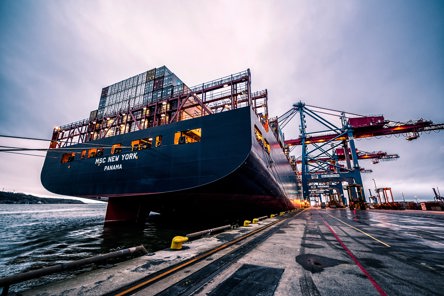Order fulfillment encompasses the entire process of receiving inventory, processing, picking and packing orders, and shipping to customers. For ecommerce brands, fulfillment capacity and operational efficiency must expand alongside sales growth to avoid frustrating order delays or backlogs. But adding more staff and infrastructure can be complex and costly.
By outsourcing fulfillment to a third-party logistics (3PL) partner, businesses can tap into specialized expertise and flexible networks to scale up or down seamlessly. Fulfillment partners become invaluable in removing constraints to support sustainable business growth across channels and markets.
DEMYSTIFYING THE COMPLEX WORLD OF ORDER FULFILLMENT
At a high level, order fulfillment includes:
Receiving inventory shipments from suppliers into the warehouse and preparing items for efficient storage based on velocity, characteristics and seasonality. Proper planning enables quickly locating products when it's time to fulfill orders.
Processing orders involves verifying payment details, assigning tracking numbers, and ensuring data flows smoothly into the warehouse management systems that orchestrate workflows. Accurate order information is crucial for proper fulfillment.
Picking requires selecting or gathering the right items from inventory to fulfill each unique order. Optimization of routing, batching, cart configurations using pick tickets or handhelds minimizes wasted motion and time.
Packing means safely preparing orders to avoid shipping damage based on item fragility while also generating compliant shipping labels. Added services like gift wrapping or custom branded inserts provide value.
Shipping orders to customers’ delivery addresses via the optimal carrier and service level balancing cost, speed and tracking visibility. Integration with carrier APIs eases dispatch.
Managing returns, exchanges and refunds must also operate smoothly. Inspection, triage and return to sellable stock or resale channels needs to be streamlined.
3PLS OPERATE DEDICATED NATIONWIDE FULFILLMENT NETWORKS
3PLs maintain dedicated warehouses staffed with trained fulfillment professionals who leverage specialized technologies and process optimizations. Their capabilities encompass:
- A national fulfillment center network positioned strategically for timely, affordable delivery to population centers. Locations on both coasts and inland.
- Scalable storage, picking modules and shipping infrastructure to flexibly adjust capacity in alignment with client order volumes and items.
- Advanced warehouse management systems (WMS) to orchestrate complex order workflows from intake to last mile delivery across sales channels.
- Real-time inventory visibility and business intelligence reporting on items, orders, throughput, productivity and more to inform decisions.
- Support for omnichannel order processing. Retail store replenishment programs, BOPIS, drop shipping, kitting/assembly and more.
- Value-added services like gift wrapping, custom packaging, compliance labeling and more to delight customers.
The economies of scale, specialized skills and process optimization of 3PL networks provide major cost and capability advantages compared to in-house fulfillment for most brands.
KEY DRIVERS AND TIMING FOR OUTSOURCING FULFILLMENT
There are certain triggers and situations that indicate a business is likely ready to outsource fulfillment. These include:
- Warehouse space filling up rapidly, unable to support intake of new inventory. Scaling constrained by existing four walls and layouts.
- Order volumes spiking well beyond current capacity. In-house staff overwhelmed, struggling to fulfill orders on time, backlogs growing.
- Adding new products or categories that don’t fit efficiently into current facility storage and picking configurations. A poor match for existing workflows.
- Expanding into major new sales channels like Amazon, large retailers, or additional countries that strain systems and staff.
- Lacking labor, resources or expertise to efficiently handle the 40-60 percent seasonal order surge typical of peak holiday periods. Overtime costs and temps soaring.
Transitioning to outsourced experts provides immediate space, staffing, and optimized processes to address these constraints and sustain growth without major capital investment. It also allows focusing precious resources on developing exceptional products and customer experiences rather than daily distribution operations.
For brands currently managing fulfillment in-house, evaluating existing warehouse management, inventory planning, and productivity capabilities is wise. Leveraging 3PL expertise rather than building skills and systems internally accelerates the expansion journey.
WHY OUTSOURCED FULFILLMENT DELIVERS STRATEGIC VALUE
The multifaceted advantages of outsourcing order fulfillment rather than managing 100 percent in-house include:
Cost Efficiency: 3PLs can achieve significantly lower fulfillment costs for most clients compared to in-house operations through load balancing across thousands of clients, and far lower fixed asset costs. Pay only for services used rather than carrying excess facility space and staff year-round.
Specialization: 3PL warehouse professionals focus on continuous optimization and process innovation rather than tactical work. This brings sophisticated solutions in automation, labor management and inventory control that brands struggle justifying themselves.
Flexibility: 3PLs readily adjust space, labor, inventory buffers and workflows to accommodate seasonal peaks, new product launches or sales channel additions. They provide continuity if disasters ever disrupt in-house sites.
Technology Enablement: Many brands lack expertise deploying complex fulfillment management software, automation, advanced analytics and more that 3PLs make readily accessible.
Focus: Outsourcing enables brands to concentrate strategic resources on developing amazing products, impactful marketing and exceptional customer experiences rather than distribution operations.
EVALUATING AND SELECTING THE RIGHT FULFILLMENT PARTNER
Choosing the optimal 3PL partner is crucial to realizing these transformational benefits. Important criteria for evaluation include:
- Proven order accuracy and on-time delivery track record for clients based on warehouse KPIs and performance management rigor
- Flexible contractual terms and capabilities that align with seasonal business needs and multi-channel processes
- Ability to efficiently meet peak demand during seasonal spikes like Black Friday through dedicated capacity
- Relevant experience with your specific product categories, throughput volumes and omnichannel services
- Breadth and sophistication of their warehouse management systems, automation technologies and tools
- National and regional fulfillment center footprint that supports cost-efficient delivery times
- Cultural fit and shared values for a collaborative, evolving long-term partnership
The 3PL’s client portfolio and vertical expertise demonstrates real-world capabilities handling similar business requirements at scale. Assessing financial stability also provides confidence in ongoing viability and service consistency.
Touring potential 3PL facilities enables assessing capabilities firsthand through observation. And of course, evaluate overall value relative to managing fulfillment in-house factoring all expenses, strategic impacts, risks and challenges.
BEST PRACTICES FOR IMPLEMENTATION AND ONBOARDING
Transitioning from self-managed fulfillment to optimized 3PL partners deserves meticulous planning and phased execution:
- Pilot first with a smaller product set or non-core sales channel before full commitment. Test integrations.
- Align order data flows, inventory tracking, key metrics and reporting visibility collaboratively upfront.
- Define KPIs for accuracy, timeliness, responsiveness and monitor routinely to ensure excellence.
- Schedule periodic business reviews to re-optimize solutions as volumes, products, channels evolve over time.
- Provide volume forecasts, projections and inventory requirements well ahead of peak seasons to align labor, space and transportation appropriately.
The expertise, technologies and flexible infrastructure of 3PLs remove major fulfillment constraints to sustainably scale businesses. Contact SEKO to explore our customizable solutions tailored to your needs, whether launching new channels or entering new regions. Our managed services enable you to focus on delighting customers as your brand grows.





